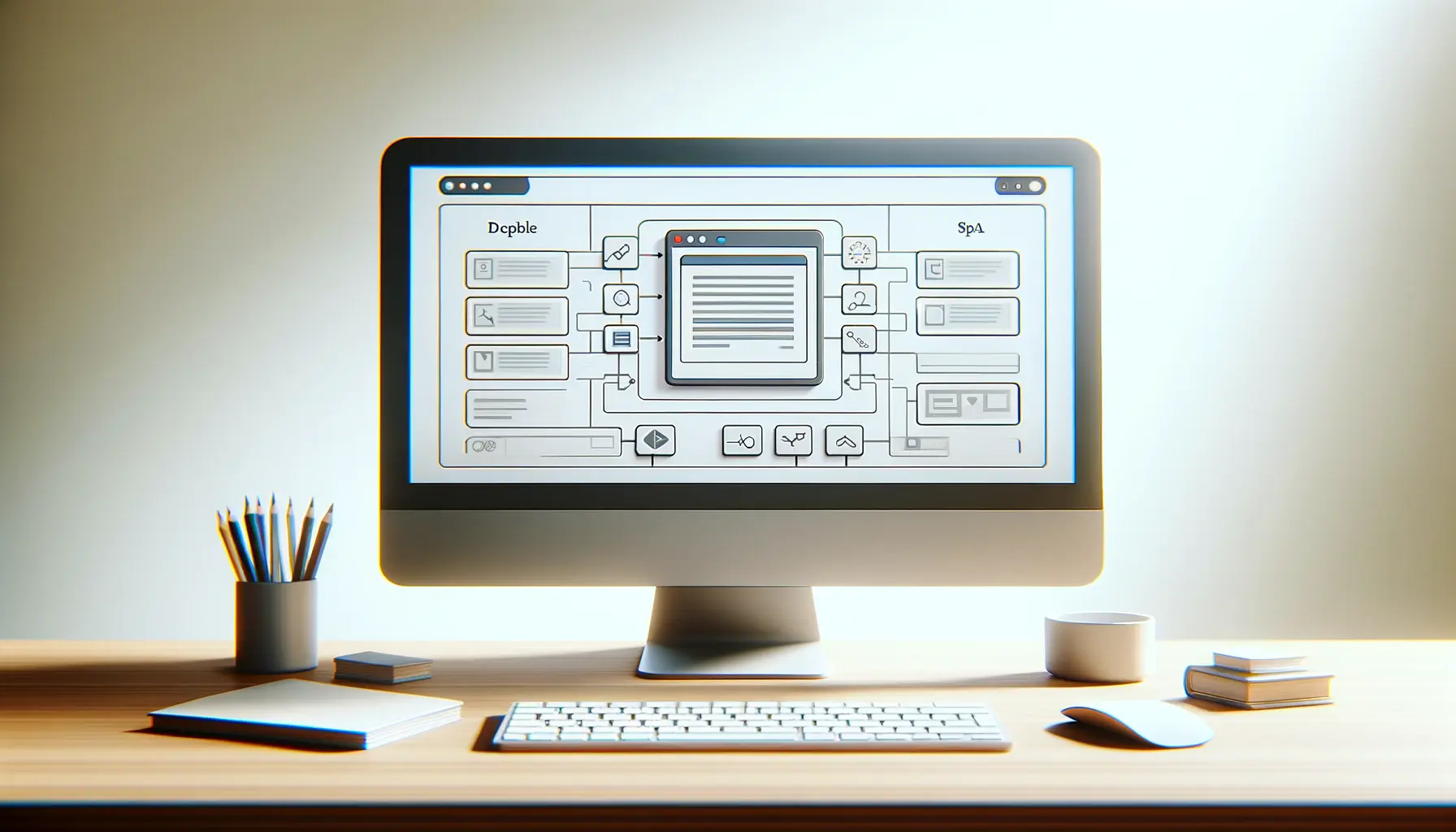Single-Page Applications (SPAs) have revolutionized the way we experience the web.
By enabling a smoother, faster user experience akin to desktop applications, SPAs have become a cornerstone of modern web development.
The essence of an SPA lies in its ability to update the user interface dynamically by communicating with the web server in the background, rather than loading entire new pages.
This approach not only enhances performance but also provides a seamless user experience, making it a preferred choice for developers and businesses alike.
However, deploying SPAs effectively requires a nuanced understanding of both their strengths and potential pitfalls.
The process involves more than just technical execution; it demands a strategic approach to ensure that the application is scalable, maintainable, and capable of delivering a high-quality user experience.
This article aims to delve into the intricacies of SPA deployment, offering insights and strategies to leverage their full potential within the JavaScript ecosystem.
- Understanding SPA Architecture
- Optimizing Performance for SPAs
- Enhancing SPA Security
- SEO Optimization for SPAs
- User Experience and Accessibility in SPAs
- Analytics and Monitoring in SPAs
- Future Trends in SPA Development
- Concluding Thoughts on Deploying SPAs Effectively
- FAQs on Deploying Single-Page Applications Effectively
Understanding SPA Architecture
The architecture of a Single-Page Application is fundamentally different from traditional multi-page applications.
At its core, an SPA loads a single HTML page and dynamically updates the content as the user interacts with the app.
This is achieved through the use of AJAX (Asynchronous JavaScript and XML) calls for data fetching and manipulation, allowing the page to update without reloading.
The heavy lifting is done on the client side, with JavaScript frameworks like Angular, React, or Vue.js managing the UI updates.
This client-side focus presents unique challenges and opportunities.
For developers, it means a shift towards more complex JavaScript codebases and the need for robust state management solutions.
For users, it translates to faster, more responsive web experiences.
The key to effective SPA deployment lies in understanding these dynamics and optimizing the application’s architecture to balance load times, performance, and user engagement.
Benefits of SPA Architecture
- **Improved User Experience:** SPAs offer a smooth, app-like user experience, with minimal page reloads and seamless transitions between different parts of the application.
- **Efficient Data Communication:** By communicating with the server in the background, SPAs can reduce bandwidth usage and improve overall performance.
- **Simplified Development Process:** With the front-end and back-end decoupled, developers can focus on building and testing the UI separately from the server-side logic.
Challenges in SPA Deployment
Despite their advantages, SPAs come with their own set of challenges.
One of the main issues is SEO optimization, as search engines traditionally have difficulty indexing content loaded dynamically with JavaScript.
Additionally, the initial load time of an SPA can be higher than traditional applications, as the browser needs to load the framework and the application code before displaying any content to the user.
To mitigate these challenges, developers must employ strategies such as server-side rendering (SSR) or pre-rendering for SEO purposes and optimize asset delivery to reduce initial load times.
Understanding these challenges and planning for them from the outset of the project is crucial for deploying an SPA effectively.
Effective SPA deployment hinges on a deep understanding of its architecture, optimizing for performance, and addressing SEO and initial load time challenges.
Optimizing Performance for SPAs
Performance optimization is a critical aspect of deploying Single-Page Applications effectively.
Given that SPAs rely heavily on client-side JavaScript, identifying and mitigating potential bottlenecks is essential for ensuring a fast, responsive user experience.
Performance optimization encompasses various strategies, from code splitting and lazy loading to caching and efficient data fetching.
One of the first steps in optimizing an SPA is to minimize the size of the JavaScript bundle.
This can be achieved through techniques such as tree shaking, which removes unused code from the bundle, and minification, which reduces the file size by eliminating unnecessary characters.
These practices help in speeding up the initial load time, a common concern for SPAs.
Implementing Code Splitting and Lazy Loading
Code splitting is a technique that divides the application’s code into smaller, manageable chunks that are loaded on demand.
This means that users only download the code necessary for the initial view, significantly reducing the initial load time.
When combined with lazy loading, which defers the loading of non-critical resources until they are needed, code splitting can dramatically improve the performance of an SPA.
Frameworks like React, Angular, and Vue offer built-in support for code splitting and lazy loading, making it easier for developers to implement these optimizations.
By strategically splitting the code and loading resources lazily, SPAs can provide a more efficient, user-friendly experience.
Optimizing Data Fetching and State Management
Efficient data fetching and state management are crucial for maintaining high performance in SPAs.
Over-fetching data can lead to unnecessary network requests and data processing, while under-fetching can cause delays due to additional requests.
Implementing a robust state management solution helps in managing the application’s state in a predictable manner, reducing the complexity and improving performance.
Techniques such as caching and service workers can be employed to minimize network requests and provide faster access to data.
Caching stores copies of resources or data fetched from the server, allowing the application to load them from the cache on subsequent requests rather than fetching them again.
Service workers, on the other hand, act as a proxy between the web application and the network, enabling offline support and resource caching.
By focusing on optimizing code delivery and improving data fetching and state management strategies, developers can significantly enhance the performance of SPAs, leading to a better user experience.
Enhancing SPA Security
Security is a paramount concern in the deployment of Single-Page Applications, as their reliance on client-side processing presents unique vulnerabilities.
Ensuring the security of an SPA involves safeguarding against a range of threats, from cross-site scripting (XSS) attacks to data interception and manipulation.
Developers must adopt comprehensive security practices to protect sensitive data and maintain user trust.
One fundamental security measure is the implementation of Content Security Policy (CSP).
CSP is a browser feature that helps detect and mitigate certain types of attacks, including Cross Site Scripting (XSS) and data injection attacks.
By specifying the domains that the browser should consider as valid sources of executable scripts, CSP prevents the execution of unsafe scripts, thus enhancing the security of the application.
Secure Data Communication
- **HTTPS:** Ensuring all data transmitted between the client and server is encrypted via HTTPS is crucial for protecting against man-in-the-middle (MITM) attacks.
- **Token-based Authentication:** Implementing token-based authentication mechanisms like JWT (JSON Web Tokens) can secure API requests by ensuring that only authenticated users can access sensitive data.
- **API Security:** Securing the API endpoints that the SPA communicates with is essential. This includes validating input data to prevent SQL injection and other injection attacks.
Client-Side Security Practices
- **Sanitizing Input:** Actively sanitizing user input to prevent XSS attacks is critical. Frameworks like Angular and React offer built-in XSS protection, but additional precautions should be taken for custom components.
- **Using Web Storage Securely:** While local storage and session storage provide convenient ways to store data on the client side, they are vulnerable to XSS attacks. Sensitive information should be stored securely and never exposed to the client-side storage.
- **Regular Security Audits:** Conducting regular security audits and keeping the SPA’s dependencies up to date are effective ways to identify and mitigate vulnerabilities.
Adopting a layered approach to security, encompassing both server-side and client-side measures, is essential for the effective deployment of Single-Page Applications.
SEO Optimization for SPAs
Search Engine Optimization (SEO) poses a unique challenge for Single-Page Applications due to their dynamic nature and reliance on JavaScript for content rendering.
Traditional search engines may struggle to index content that is loaded asynchronously, potentially impacting the SPA’s visibility and ranking.
However, with the right strategies, it’s possible to optimize SPAs for search engines effectively, ensuring they are discoverable and rank well.
Server-Side Rendering (SSR) is a powerful technique for improving the SEO of an SPA.
SSR involves rendering the initial state of the application on the server and sending the fully rendered page to the client.
This approach ensures that search engine crawlers can access the content without executing JavaScript, making the SPA’s content fully indexable.
Pre-rendering Static Content
- **Pre-rendering:** For SPAs that do not require real-time data for the initial page load, pre-rendering can be an effective SEO strategy. Pre-rendering generates static HTML files for each route in advance, ensuring that search engine crawlers can access the content.
- **Dynamic Rendering:** Dynamic rendering serves different content to users and search engines. While users receive the JavaScript-powered version of the site, crawlers are served a static version, ensuring the content is indexed.
Enhancing SPA SEO with Metadata and URLs
- **Meta Tags and Rich Snippets:** Utilizing meta tags and structured data to provide search engines with detailed information about the page content can significantly enhance an SPA’s SEO. Tools like React Helmet or Vue Meta allow for dynamic manipulation of meta tags based on the current route.
- **Clean, Descriptive URLs:** Ensuring that the SPA uses clean, descriptive URLs for each view or state not only improves user experience but also aids search engines in understanding and indexing the content.
- **XML Sitemaps and Robots.txt:** Providing an XML sitemap helps search engines discover all the pages within the SPA, while a correctly configured robots.txt file can guide crawlers to the content that should be indexed.
Adopting server-side rendering, pre-rendering, and dynamic rendering techniques, along with optimizing metadata and URLs, are key strategies for enhancing the SEO of Single-Page Applications.
User Experience and Accessibility in SPAs
Ensuring a positive user experience (UX) and accessibility in Single-Page Applications is crucial for engaging and retaining users.
SPAs offer the potential for highly interactive and responsive user interfaces, but without careful design and implementation, they can also introduce usability and accessibility challenges.
Addressing these aspects from the outset of SPA development is essential for creating inclusive and effective web applications.
Enhancing UX involves optimizing the application’s performance, ensuring intuitive navigation, and providing immediate feedback to user interactions.
Accessibility, on the other hand, requires making the application usable for everyone, including people with disabilities.
This includes semantic HTML, keyboard navigation, screen reader support, and adherence to the Web Content Accessibility Guidelines (WCAG).
Improving Navigation and Feedback
- **Dynamic Routing:** Utilizing frameworks’ routing capabilities allows for the creation of descriptive URLs and the management of browser history, improving the navigability of SPAs.
- **Loading Indicators:** Providing visual feedback during data fetching operations keeps the user informed about the application’s state, enhancing the overall UX.
Ensuring Accessibility
- **Semantic HTML:** Using semantic HTML elements ensures that the structure of the content is meaningful both for users and assistive technologies.
- **ARIA (Accessible Rich Internet Applications) Landmarks:** Implementing ARIA roles, properties, and states enhances the accessibility of dynamic content and complex UI components in SPAs.
- **Keyboard Navigation:** Ensuring that all interactive elements are accessible via keyboard is fundamental for users who cannot use a mouse.
- **Testing with Screen Readers:** Regular testing with screen readers helps identify and fix accessibility issues, ensuring that the SPA is usable by people with visual impairments.
Focusing on user experience and accessibility from the early stages of SPA development ensures that the application is not only performant and engaging but also inclusive and accessible to all users.
Analytics and Monitoring in SPAs
Implementing robust analytics and monitoring within Single-Page Applications is essential for understanding user behavior, tracking performance, and identifying issues in real-time.
Unlike traditional multi-page applications, SPAs present unique challenges for analytics due to their dynamic nature.
Each user interaction that changes the view or state of the application doesn’t result in a new page load, which can complicate tracking user journeys and interactions.
To effectively gather insights and ensure optimal performance, developers must integrate SPA-specific analytics and monitoring tools.
These tools can track custom events, measure performance metrics, and monitor errors as users navigate the SPA, providing valuable data that can inform improvements and optimizations.
Integrating SPA-Specific Analytics
- **Custom Event Tracking:** Utilizing analytics platforms that support custom event tracking allows developers to measure specific interactions within the SPA, such as button clicks, form submissions, and dynamic content loading.
- **User Journey Mapping:** By tracking route changes as virtual pageviews, analytics tools can reconstruct user journeys through the SPA, offering insights into user behavior and application flow.
Performance and Error Monitoring
- **Real User Monitoring (RUM):** RUM tools specifically designed for SPAs can measure critical performance metrics, such as time to first byte (TTFB), first contentful paint (FCP), and time to interactive (TTI), directly from real users’ browsers.
- **Error Tracking and Logging:** Integrating error tracking solutions helps capture and log runtime errors, unhandled exceptions, and API failures, enabling developers to quickly identify and resolve issues.
Effective analytics and monitoring in SPAs not only enhance the understanding of user engagement and application performance but also play a crucial role in continuous improvement and user satisfaction.
Future Trends in SPA Development
The landscape of Single-Page Application development is continuously evolving, driven by advancements in technology, changing user expectations, and the growing complexity of web applications.
As we look towards the future, several trends are set to shape the development and deployment of SPAs, influencing how developers build engaging, performant, and scalable web applications.
One significant trend is the increasing adoption of JavaScript frameworks and libraries that offer more efficient ways to build SPAs.
React, Vue.js, and Angular continue to evolve, introducing new features and optimizations that enhance performance and developer experience.
Additionally, the rise of serverless architectures and edge computing is transforming how SPAs are deployed and served, enabling more scalable and cost-effective solutions.
Advancements in Frameworks and Tools
- **Progressive Web Apps (PWAs):** The convergence of SPAs with Progressive Web Apps offers the best of both worlds, combining the high performance and user experience of SPAs with the offline capabilities and app-like features of PWAs.
- **Component-Based Architecture:** The shift towards a more modular, component-based architecture facilitates reuse and scalability, allowing developers to build complex applications more efficiently.
Enhancing User Experience with AI and Machine Learning
- **Personalization:** Leveraging AI and machine learning to analyze user data and behavior can enable highly personalized user experiences, tailoring content and interactions to individual preferences.
- **Intelligent Performance Optimization:** AI-driven tools can automatically optimize application performance, dynamically adjusting resources and content delivery based on real-time user engagement and conditions.
Assuming that the current tools and practices for SPA development will remain static is a misconception. The field is rapidly advancing, with new technologies and approaches emerging that promise to further enhance the capabilities and reach of Single-Page Applications.
Concluding Thoughts on Deploying SPAs Effectively
The journey through the intricacies of deploying Single-Page Applications (SPAs) effectively reveals a landscape filled with opportunities and challenges.
From optimizing performance and enhancing security to ensuring SEO friendliness and prioritizing user experience, the development of SPAs demands a multifaceted approach.
As we’ve explored, the key to success lies in leveraging the latest advancements in technology while maintaining a keen focus on the end-user experience.
Embracing Future Trends
The future of SPA development is bright, with emerging trends promising to elevate the capabilities and performance of these applications.
The integration of Progressive Web Apps (PWAs), the adoption of serverless architectures, and the potential of AI and machine learning to personalize user experiences are just a few developments on the horizon.
As these technologies continue to evolve, they will undoubtedly shape the next generation of SPAs, making them even more powerful, user-friendly, and accessible.
Strategic Deployment for Success
Effectively deploying SPAs requires a strategic approach that encompasses not only technical execution but also a deep understanding of user needs and behaviors.
By focusing on performance optimization, robust security measures, SEO strategies, and user experience enhancements, developers can create SPAs that not only meet but exceed user expectations.
Moreover, the continuous monitoring and analysis of user interactions and application performance data will enable ongoing improvements, ensuring that SPAs remain relevant and engaging in a rapidly changing digital landscape.
- Adopting modern JavaScript frameworks and tools for efficient development
- Implementing server-side rendering or pre-rendering for improved SEO
- Ensuring accessibility and usability for all users
- Leveraging analytics and monitoring to inform continuous improvement
In conclusion, the effective deployment of Single-Page Applications is a dynamic and ongoing process that requires attention to detail, a commitment to excellence, and an openness to innovation.
By embracing the best practices and future trends outlined in this article, developers and businesses alike can harness the full potential of SPAs to deliver exceptional web experiences that drive engagement, satisfaction, and success.
Quality web design is key for a great website! Check out our service page to partner with an expert web design agency.
FAQs on Deploying Single-Page Applications Effectively
Explore common questions about deploying SPAs to enhance your understanding and implementation strategies.
An SPA is a web application that loads a single HTML page and dynamically updates content as the user interacts with the app, improving performance and user experience.
SPAs offer faster interactions, seamless user experiences, and reduced server load by handling most interactions on the client side without full page reloads.
By minimizing page reloads, SPAs provide a smooth, app-like experience with quicker navigation and immediate feedback on user actions.
SPAs face SEO challenges due to their reliance on JavaScript for content rendering, making it harder for search engines to index their dynamic content.
Yes, through techniques like server-side rendering (SSR) and pre-rendering, SPAs can be made SEO friendly by allowing search engines to index their content.
Crucial, as SPAs rely on client-side rendering. Performance optimization ensures fast load times and a responsive user interface, enhancing the overall user experience.
SPAs must address security issues like cross-site scripting (XSS) and data interception by implementing secure data communication and validation practices.
Through Real User Monitoring (RUM) tools that track custom events, performance metrics, and errors, providing insights into user behavior and application efficiency.











